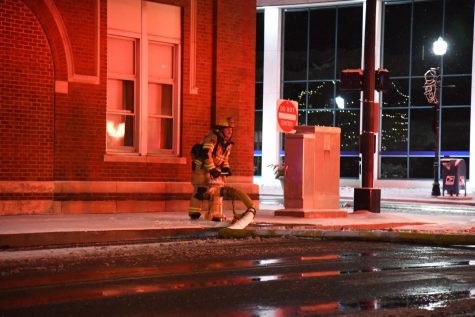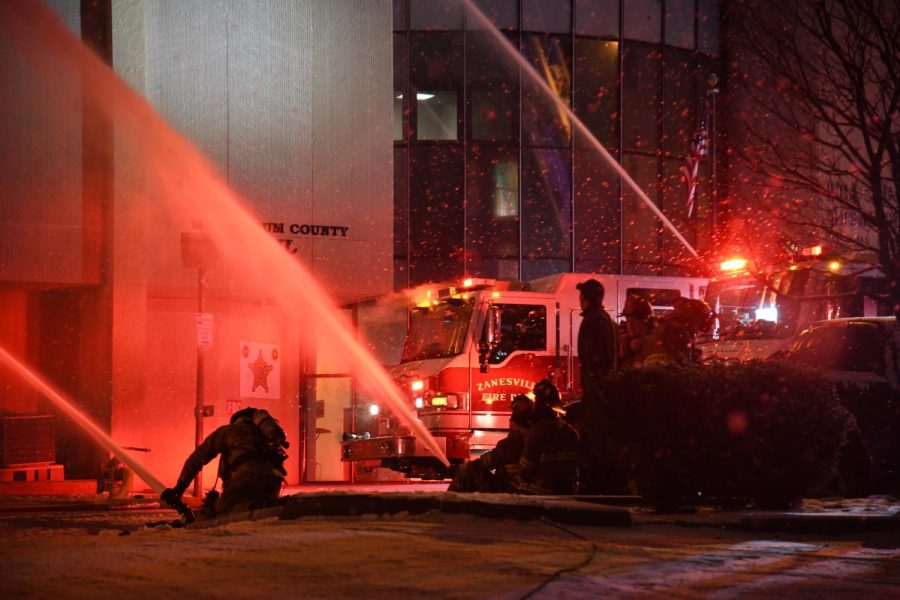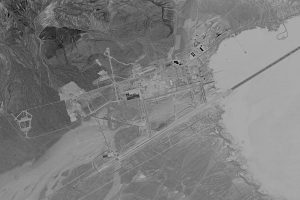Millions of gallons of water used in extinguishing Masonic Temple fire
January 10, 2022
A blaze that destroyed the historic Masonic Temple in downtown Zanesville, one of the largest fires in living community memory, pulled resources from around the county, but it also pulled millions of gallons of water from city pipelines.
Utilizing numerous hydrants, firetrucks including towers, ladders and engines, from as far away as New Concord, pressurized water and fed it onto and inside the building, combating the blaze and preventing it from expanding to other downtown buildings, including the adjacent county jail.
Without the steady supply of water, it’s possible that firefighters wouldn’t have had the ability to hold the fire at bay, protecting lives and other historic structures which dot the downtown.
Within a minute of receiving the call that a man was trapped inside the building located along North 4th Street, crews were not only on the scene planning a rescue but a way to combat the fire.
Many firetrucks contain various-sized reserves of water inside, capable of putting it on a fire, while a connection to a more constant supply is established.
In rural areas without water lines, tankers are used, in the city, where lines are more ubiquitous, hydrants provide the vital link.
After successfully extracting the man, crews turned their attention to providing that necessary connection.
At multiple intersections that comprised the block south of city hall and north of Huntington Bank, between North 4th Street and North 5th Street, hydrants sit ready to provide that rarely used intended function.

During the fire, multiple times, commanders could be heard asking dispatch to let the proper officials at the city know they would need to provide additional water capacity.
By the use of certain particular hydrants, it also appears firefighters wanted to ensure they didn’t unintentionally siphon off the water supply to crews at other strategic points around the structure fighting the blaze.
According to Zanesville Water Superintendent Scott Bryant, it’s possible to roughly calculate how much water was used by finding the difference between the daily average water consumption of the city and that the night of the fire and into the following days.
Between Saturday, January 1, and Wednesday, January 5, the treatment plant’s average daily production was 3.611 million gallons. On Thursday, January 6, it was 4.162 million gallons. The following day, it was 5.774 million gallons, nearly 2.163 additional million gallons of water.
From the start of the fire around 10:45 p.m. Thursday night and Sunday, January 9, at midnight, 3.675 million gallons of additional water were produced and sent through city lines.
In an ad hoc interview with media early Friday morning, Zanesville City Fire Chief Jeff Bell explained the dilemma facing firefighters.
With each additional gallon of water put into the building, which weighs roughly eight-and-a-half pounds, it exerted downward pressure on the floors which were already extremely compromised, if not already gone, due to the fire. However, crews also had the responsibility to stop the fire from spreading to nearby structures.
The Masonic Temple was not equipped with any fire impression system, which is now required for all large commercial buildings.
Built beginning in 1903, the structure used mostly old regional growth trees for its supporting beams that were themselves supported by steel beams throughout the building.
As of Monday afternoon, the cause of the fire has yet to be determined.














SHARON BOLES • Jan 10, 2022 at 4:27 pm
Thank you for this amazing article. I thought that firemen hooked up to a hydrant and put out the fire. This article told how water flow is really handled and what has to be done to keep the water usage balanced to fight the fire. Even I could understand how it works.
Thank you again.
You are appreciated.
HAPPY NEW YEAR